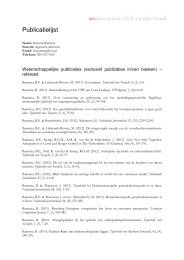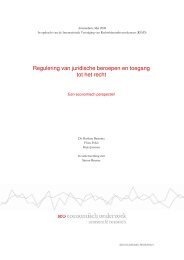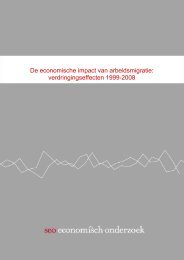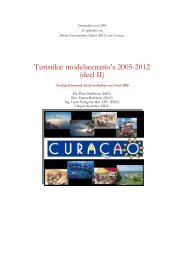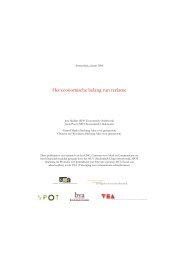Figure 3-1: Components of an innovation systemSource: OECD (2003: 9)Modern innovation models describe the network of relationships among academia, industry, andgovernment as an overlay of reflexive communications that increasingly reshape the institutionalarrangements. (Etzkowitz and Leydesdorff, 2000: 109). The linear innovation model eitherexpressed in terms of ‘‘market pull’’ or ‘‘technology push’’ was insufficient to induce transfer ofknowledge and technology. Publication and patenting assume different systems of reference bothfrom each other and with reference to the transformation of knowledge and technology intomarketable products (ibid: 110). Modern, non-linear, models of innovation extend upon linearmodels by taking interactive and recursive terms into account. These non-linear terms can beexpected to change the causal relations between input and output (ibid: 114). There are severalmodern non-linear innovation models that can be used to conceptualize the interaction betweenHEIs and industry in relation to research and innovation.Gibbons et al. (1994) argue that a new form of knowledge production started emerging from themid 20 th century which is context-driven, problem-focused and interdisciplinary. It involvesmultidisciplinary teams brought together for short periods of time to work on specific problems inthe real world. Gibbons et al. label this ‘mode 2’ knowledge production. This is to bedistinguished from traditional academic, investigator-initiated and discipline-based knowledgeproduction, which they label ‘mode 1’. Other innovation models that are indicative of flux,reorganization, and the enhanced role of knowledge in the economy and society are ‘nationalsystems of innovation’ (Edquist, 1997), ‘research systems in transition’ (Cozzens et al., 1990;Ziman, 1994) or ‘the post modern research system’ (Rip and Van der Meulen, 1996).The Triple Helix configuration of university-industry-government relations assumes that anetwork of overlay communications, networks and organizations continuously reshapes theinstitutional arrangements in the innovation system. Most countries and regions have presentlyattained what Etzkowitz and Leydesdorff (2000: 111) call Triple Helix III type of innovationmodel; a knowledge infrastructure in which the three institutional spheres are overlapping, witheach taking the role of the other and hybrid organizations emerging at the interfaces. Thecommon objective is to realize an innovative environment consisting of university spin-off firms,tri-lateral initiatives for knowledge-based economic development, and strategic alliances amongfirms (large and small, operating in different areas, and with different levels of technology),government laboratories, and academic research groups (ibid:112).54
Bodas Freitas and Verspagen (2009) have developed a theoretical framework to conceptualize theinteraction between HEIs and industry in relation to research and innovation in the <strong>Netherlands</strong>.This theoretical framework asserts that knowledge transfer between HEIs and industry isinherently problematic. First of all, the process by which knowledge among HEIs gets intopractice is complex, interactive and risky. Technological and market problems seem to be thebiggest risks in the process of bringing knowledge into industrial innovations, independent ofwhether this process can be characterized as supply-push or demand-pull. Secondly, researchersat HEIs and industry collaborate for very different reasons: somewhat oversimplified, universityresearchers have incentives to concentrate on fundamental and theoretical research, publishingtheir research results, being recognized by their peers and assuring their tenure; while industrialresearchers are driven to focus on applicability and appropriation of the generated knowledge, oncommercially viable technologies, and on solving technological problems. Thirdly, collectiveHEI-industry knowledge production and especially the attribution of its research results may beproblematic because it requires finding a common agreement on a balanced level of appropriationby the participating firm and of public diffusion of results.Given the difficulties inherent to the process of bringing inventions into practice as well as inbridging university and industrial motivations towards collaboration, policy measures are nowwidely present in developed countries. In particular, to encourage knowledge transfer betweenuniversity and industry, policy-makers introduced public sponsoring to collaborative researchprojects, stimulated the establishment of university’s Technology Transfer Offices (TTOs) andpart-time professorships, and pushed for more active use of university property rights (ibid: 6).Public research sponsoring may help bridging HEI and industry motivations for collaboration inR&D as well as for engaging in efficient translation of new scientific advances into commerciallyviable technologies and products (Lee and Gaertner, 1994).3.2.2 National legal frameworkThe Dutch legislation on the ownership of Intellectual Property Rights (IPRs) is embodied in theIntellectual Property Act (Rijksoctrooiwet) of 1995. The Dutch Intellectual Property Act (IPA)stipulates that when someone conducts research at a university, UAS or research institution, thepatent entitlement belongs to the university, UAS or research institution.As a result, only the HEI can enter into arrangements to exploit the IPRs generated in theinstitutions. Further, HEIs themselves are allowed to set framework conditions regarding theownership of IPRs. In general terms, there are three different modes:• IPRs generated via HEI-financed research: in this case the HEI owns all rights to the IPR;• IPRs generated in the framework of a (research) contract for a particular (large or small)company: HEI can enter into a contract specifying who owns what and which party ownsthe right to exploit the IP generated from this contract;• IPRs generated in a research consortium: a research consortium formed to carry out aproject under a European Framework Programme – the terms for exploitation are writtendown in a Consortium Agreement among the partners and at the end of the project thepartners have to submit an exploitation plan. Most often, the results are co-owned by allpartners, although exceptions are possible.The University of <strong>Amsterdam</strong> (UvA), for instance, has the following division rule for revenuesobtained from inventions made by its employees: one-third goes to the inventor, one-third to thefaculty where the inventor is employed, and one-third to the Octrooifonds (a fund established bythe university to pay for the costs associated with patent requests).55
- Page 1 and 2:
Please cite this paper as:SEO Econo
- Page 6 and 7:
2.3 Higher education and the labor
- Page 8 and 9:
6.3 Mechanisms to promote regional
- Page 10 and 11:
Table 4-4: Completion rates of diff
- Page 12 and 13: LSCA Life Sciences Center Amsterdam
- Page 14 and 15: such as regional authorities and th
- Page 17 and 18: 1. OVERVIEW OF THE REGION1.1 Introd
- Page 19 and 20: the southEastern part of Amsterdam
- Page 21 and 22: elatively bad accessibility of the
- Page 23 and 24: metropolitan area exceeded that of
- Page 25: egion suffer from one of the follow
- Page 28 and 29: Figure 1-7: Dropouts secondary educ
- Page 30 and 31: Figure 1-9: Employment in Amsterdam
- Page 32 and 33: high-tech sectors is relatively hig
- Page 34 and 35: 1.4.4 Labor market indicatorsTable
- Page 36 and 37: The central government is responsib
- Page 38 and 39: implemented. There is also an admin
- Page 41 and 42: 2 CHARACTERISTICS OF THE HIGHER EDU
- Page 43 and 44: Source: MinOCW (2007a: 68), EU (199
- Page 45 and 46: (ibid: 83). In part, this new syste
- Page 47 and 48: Table 2-1: Student enrolment at UAS
- Page 49 and 50: Figure 2-5: Students at universitie
- Page 51 and 52: Figure 2-6: Participation in tertia
- Page 53 and 54: also show a continued high demand f
- Page 55 and 56: not receive funding from the govern
- Page 57 and 58: of diplomas awarded and the number
- Page 59: decision is up to the HEI itself. I
- Page 64 and 65: 3.2.3 National funding frameworkThe
- Page 66 and 67: challenge for the years to come wil
- Page 68 and 69: Figure 3-3: R&D expenditures in Noo
- Page 70 and 71: Amsterdam Topstad programme.Creativ
- Page 72 and 73: 3.5.3 Life SciencesGiven the high l
- Page 74 and 75: Figure 3-4: Employment in Amsterdam
- Page 76 and 77: years. Employment in the trade and
- Page 78 and 79: employment has no upward or downwar
- Page 80 and 81: and more efficient exploitation of
- Page 82 and 83: mostly happens in the context of R&
- Page 84 and 85: income related to IP rights. The fa
- Page 86 and 87: Figure 3-6: Regional innovation sys
- Page 88 and 89: HEIs to play this role, as it draws
- Page 91 and 92: 4 CONTRIBUTION OF TEACHING & LEARNI
- Page 93 and 94: housing market, on the ‘buying ma
- Page 95 and 96: transport, finance, financial manag
- Page 97 and 98: HvA participates in several initiat
- Page 99 and 100: 4.4 Student recruitment and regiona
- Page 101 and 102: 4.4.1.2 Recruitment of foreign stud
- Page 103 and 104: • HvA has made its educational pr
- Page 105 and 106: The HEIs have several external and
- Page 107 and 108: Table 4-4: Completion rates of diff
- Page 109 and 110: 4.7 Enhancing the regional learning
- Page 111 and 112: 4.8 ConclusionTable 4-6: SWOTStreng
- Page 113:
Amsterdam is matched by a relative
- Page 116 and 117:
The challenge for future social pol
- Page 118 and 119:
The VU likewise develops research p
- Page 120 and 121:
directing, documentary directing, s
- Page 122 and 123:
the university to improve its energ
- Page 125 and 126:
6.1 Introduction6 CAPACITY BUILDING
- Page 127 and 128:
Figure 6-1: Organization chart Vrij
- Page 129 and 130:
There are also examples of more spe
- Page 131 and 132:
Box 6-2: Obstacles for collaboratio
- Page 133 and 134:
eyond labor market studies, there a
- Page 135 and 136:
7 CONCLUSIONS: MOVING BEYOND THE SE
- Page 137 and 138:
…requires different forms of coop
- Page 139 and 140:
at higher levels in order to mainta
- Page 141 and 142:
to increase the interaction between
- Page 143 and 144:
mobility in the world is slackening
- Page 145 and 146:
ecause they are better informed abo
- Page 147 and 148:
REFERENCESAalders, R., A. Bakkeren,
- Page 149 and 150:
EZ Amsterdam (2006), “Research Bu
- Page 151 and 152:
MinOCW (2007a), “The Education Sy
- Page 153 and 154:
SER (2008), “Duurzame Globaliseri
- Page 155:
Versleijen, A., van der Meulen, B.,
- Page 158 and 159:
Institution City Type ofHEIANNEX B:
- Page 160 and 161:
Groningenculture)Hogeschool Amsterd
- Page 163 and 164:
ANNEX C: KEY ECONOMIC INDICATORSTab
- Page 165 and 166:
ANNEX E: REGIONAL PARTNERSHIPS OF A
- Page 167 and 168:
AmsterdamUniversity CollegeOther re
- Page 169 and 170:
ANNEX F: BUSINESSES REPRESENTED IN
- Page 171 and 172:
GLOSSARYBologna DeclarationForeign






